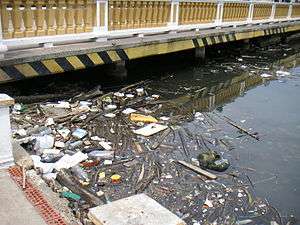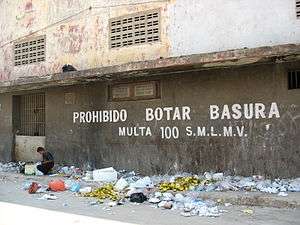Environmental issues in Colombia
Colombia Background
Environmentally, Colombia is a mega-diverse country from its natural land terrain to its biological wildlife.[1] Its biodiversity is a result of its geographical location and elevation.[2] It is the fourth largest South American country and only country in South America to have coasts in the Pacific and Caribbean ocean.[3] Colombia’s terrain can be divided into six main natural zones: The Caribbean, the Pacific (including Choco’s Biogeographic rainforest), The Orinoco region, The Amazonia region, the Andean region, and the Insular region.[3] 52.2% of the environment is predominately the Andes, Amazon, and Pacific Basins, followed by the Orinoco basin 13.9%, the Andes and the Caribbean.[3] The Tropical Andes, Choco, and the Caribbean are considered biodiversity hotspots which puts these areas at high risk of concentration of colonizing activities.[2] Colombia hosts over 1800 species and at least one new species is detected every year.[2] Decades of civil war and political unrest has impeded biological and environmental research in Colombia.[2] The political unrest in Colombia catalyzes the alteration of land patterns through the cultivation of coca and opium crops, the redirection of extractive activities, and land abandonment in some areas.[1]


There are many environmental issues in Colombia.
Current issues include deforestation resulting from timber exploitation in the jungles of the Amazon and the region of Chocó, illicit drug crops grown by peasants in the national parks of Serranía de la Macarena and Sierra Nevada de Santa Marta, and soil erosion.
There is soil and water quality damage from contamination by the use of chemicals in the coca-refining process, spillage of crude oil into the local rivers as a result of guerrilla sabotage of pipelines, and overuse of pesticides, air pollution (especially in Bogotá) from vehicle emissions, and the preservation of wildlife.
Natural hazards include highlands subject to volcanic eruptions, occasional earthquakes, and periodic droughts.
Deforestation
Colombia loses 2,000 km2 of forest annually to deforestation, according to the United Nations in 2003.[4] Some suggest that this figure is as high as 3,000 km² due to illegal logging in the region.[4] Deforestation results mainly from logging for timber, small-scale agricultural ranching, mining, development of energy resources such as hydro-electricity, infrastructure, cocaine production, and farming.[4] Around one-third of the country's original forest has been removed as a result of deforestation.
Deforestation in Colombia is mainly targeted at primary rainforest which covers more than 80% of Colombia. This has a profound ecological impact in that Colombia is extremely rich in biodiversity, with 10% of the world's species, making it the second most biologically diverse country on Earth.[4]
A national and regional deforestation study in Colombia found a total loss of 5,116,071 ha of forest between 1990 and 2005 which indicates an annual deforestation rate of 341,071 ha.[3] This concludes the national rate of deforestation equals to 0.62%.[3] Higher deforestation rates are found in flatter areas around rural locations where protected areas are more present.[3] Even though majority of ecosystems in the Amazon, the Choco, and the Orinoco remain intact, 70% of original forest in the Andes has been wiped out.[1][2] Forest conversion has the highest probability in the Andean and Caribbean territory, although tropical forest in the Pacific and Amazon lowlands continue to be exterminated.[1] The ecosystems most vulnerable to deforestation ranked: the plains in northern Amazonia, the humid high, sub, and mid-altitute Andean forests, the tropical high and low land forests in the Caribbean and the Magdalena tropical forest plains.[1] Deforestation is happening more frequently in flatter zones, where cattle density and rural population are low.[3] Illicit crop cultivation has been recorded a main driver of deforestation in Colombia.[2][3] The globalized economy has extended new engenders of deforestation, such as biofuel production, mining, and hydrocarbon extraction.[3] At the national level, rate of rural population, protected areas, cattle practicing, and slope, are deforestation drivers.[3] Forest eradication is a crucial environmental issue given the biodiversity and ecosystems these forests provide and all the life that can be potentially lost.[3][5] The concurrent forested areas predominately exist on less fertile soil and are distant from roads.[1]
Amazonian Deforestation
In Colombia, majority of forests are contained within the Amazonia.[3] The population of this region is sparsely populated engendering the zone to be concentrated by deforestation and high levels of extractive activities.[3] In the Colombian Amazonia from 1990 to 2005 there was a forest loss of 1,886,769 ha (3.9%) with an annual rate of 0.49%.[3] Deforestation in this region is accounted to population and land use.[3] The Amazonia possess a low populated area with small scale agriculture (including illegal crops), and cattle ranching.[3] Fires in the Amazon also remain as a catalyst of deforestation which is an indicator of slash and burn activities associated with exploitation of natural resources.[3] Study results suggest deforestation in the Amazonia often takes place in unoccupied rural territory where an influx of “colonist population move freely and colonization hotspots using the river” are created.[3]
Government response
New environmental protection legislation was enacted in 1991, including the creation of specially protected zones, of which more than 200 were created in the early 1990s, mostly in forest areas and national parks. As a result of this charter, the Ministry of the Environment was established in 1993, merging with the housing and drinking water division of the Ministry of Economic Development, Housing, and Potable Water in 2003.
See also
- List of invasive species in Colombia
- Animal rights in Colombia
- Narcotrafficking in Colombia
- Plan Colombia#Aerial Eradication strategy and criticisms
References
- 1 2 3 4 5 6 "Regional patterns of agricultural land use and deforestation in Colombia: Start Your Search!". eds.a.ebscohost.com. Retrieved 2016-12-03.
- 1 2 3 4 5 6 "Elevational Ranges of Montane Birds and Deforestation in the Western Andes ...: Start Your Search!". eds.a.ebscohost.com. Retrieved 2016-12-03.
- 1 2 3 4 5 6 7 8 9 10 11 12 13 14 15 16 17 18 "National and regional determinants of tropical deforestation in Colombia: Start Your Search!". eds.a.ebscohost.com. Retrieved 2016-12-03.
- 1 2 3 4 "Tropical rainforests: Colombia". Mongabay.com. Retrieved August 24, 2008.
- ↑ Moreno, Sergio; Plese, Tinka. "The Illegal Traffic in Sloths and Threats to Their Survival in Colombia". Edentata. 7 (1). doi:10.1896/1413-4411.7.1.10.
External links
- (Spanish) Colombian Ministry of Environment
![]() This article incorporates public domain material from the Library of Congress Country Studies website http://lcweb2.loc.gov/frd/cs/.
This article incorporates public domain material from the Library of Congress Country Studies website http://lcweb2.loc.gov/frd/cs/.